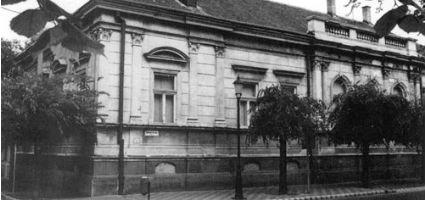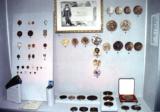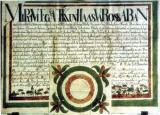2024. April 26. Friday
János Thorma Museum - Kiskunhalas
 |
Address: 6400, Kiskunhalas Köztársaság utca 2.
Phone number: (77) 422-864
E-mail: info@thormajanosmuzeum.hu
Opening hours: 01.03-30.09.: Tue-Sut 9-17
|
The collection of the museum of Kiskunhalas came to existence in 1874. According to the plaque that was revealed on its 125th anniversary: 'The collection of György Révész with the guidance of parson Áron Szilády and István Gyárfás was bought by the Reformed Church of Kiskunhalas in 1874. In the same year the by unification of the Révész-collection end the collection if the reformed secondary school for girls the Museum of Halas was born. It is commonly called, the archives collection of the primary school.
In 1935 László Nagy Czirok organized an exhibition of his own collection and objects acquired from other collectors. The few hundred objects were placed in cabinets, show-cases, and on the walls of the wards with the help of Károly Latabár who formerly lead the furnishing of the 'Lace-house'.
In WWs both of the museums were almost completely demolished. László Nagy Zcirok began re-establishing the museum. He regained and replaced many of the objects.
In 1950 the museums in Hungary were nationalized and reorganized. The case of the Museum of Kiskunhalas was also renewed. A significant result of the 1950s was the museum acquiring the collection of almost 1100 pieces of a farmer named Ferenc Molnár K.
At the beginning of 1951 László Nagy Czirok was entrusted with the managing work of the museum. Under his management the museum took on the name: János Thorma Museum. In 1953 a decision was made on the final location of the museum: it was placed in the biggest civic house of the town, the Kolozsváry mansion, built in eclectic style in 1887.
Janó Ákos (1927-) took over the leading of the museum in 1953. After the renovation works the permanent exhibition opened in 1954-ben. The building had an attachment built to it by 1960 and also a gallery apt for the showing of the paintings of Thorma.
The year 1962 brought significant changes in establishing the county museum departments. The Thorma Museum being a country museum received the task of the Kiskunhalas Museum. At the beginning of 1960 the volume titled 'The Kiskunhalas Monograph of Local history' was born between the walls of this museum.
Aurél Szakál organized the Museum of Halas foundation and in 1998 and 'The Circle of Friends of the Museum' in order to support the museum. At the 150th anniversary of the revolution two giant historic paintings of Thorma was restored as well as the gallery to show for displays: an important spectacle of the country came to existence by the creations of these. In 1999 the Thorma Museum received the title 'The Museum of the Year 1998'.
The significance of a museum is set by the size of its collection, its state, and its measure of procession. The number of the objects of the Thorma Museum is over 70 000. This collection mainly presents the memories of ethnography and local history (9000 pieces), but the visitors may find archaeological (5000) fine-and applied arts etc. material as well. The document-and data collection has 18 000 pieces, the photo collection is made up of 25 000 pieces, and the Library has 10 000 pieces.
In 1935 László Nagy Czirok organized an exhibition of his own collection and objects acquired from other collectors. The few hundred objects were placed in cabinets, show-cases, and on the walls of the wards with the help of Károly Latabár who formerly lead the furnishing of the 'Lace-house'.
In WWs both of the museums were almost completely demolished. László Nagy Zcirok began re-establishing the museum. He regained and replaced many of the objects.
In 1950 the museums in Hungary were nationalized and reorganized. The case of the Museum of Kiskunhalas was also renewed. A significant result of the 1950s was the museum acquiring the collection of almost 1100 pieces of a farmer named Ferenc Molnár K.
At the beginning of 1951 László Nagy Czirok was entrusted with the managing work of the museum. Under his management the museum took on the name: János Thorma Museum. In 1953 a decision was made on the final location of the museum: it was placed in the biggest civic house of the town, the Kolozsváry mansion, built in eclectic style in 1887.
Janó Ákos (1927-) took over the leading of the museum in 1953. After the renovation works the permanent exhibition opened in 1954-ben. The building had an attachment built to it by 1960 and also a gallery apt for the showing of the paintings of Thorma.
The year 1962 brought significant changes in establishing the county museum departments. The Thorma Museum being a country museum received the task of the Kiskunhalas Museum. At the beginning of 1960 the volume titled 'The Kiskunhalas Monograph of Local history' was born between the walls of this museum.
Aurél Szakál organized the Museum of Halas foundation and in 1998 and 'The Circle of Friends of the Museum' in order to support the museum. At the 150th anniversary of the revolution two giant historic paintings of Thorma was restored as well as the gallery to show for displays: an important spectacle of the country came to existence by the creations of these. In 1999 the Thorma Museum received the title 'The Museum of the Year 1998'.
The significance of a museum is set by the size of its collection, its state, and its measure of procession. The number of the objects of the Thorma Museum is over 70 000. This collection mainly presents the memories of ethnography and local history (9000 pieces), but the visitors may find archaeological (5000) fine-and applied arts etc. material as well. The document-and data collection has 18 000 pieces, the photo collection is made up of 25 000 pieces, and the Library has 10 000 pieces.

